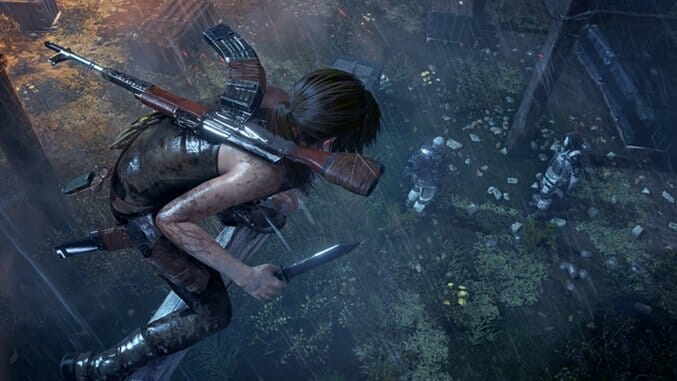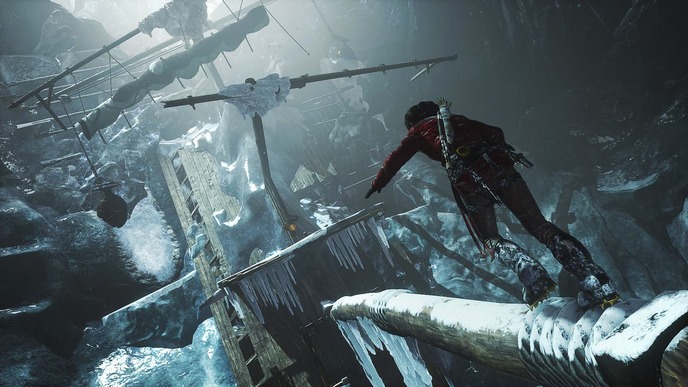
A sequel to the 2013 Tomb Raider was all but inevitable. The game, an origin story presenting Lara Croft as a young woman shipwrecked on an island inhabited by hostile mercenaries and other more supernatural dangers, was probably the best reboot of a series since Batman Begins. This game was all about her becoming a survivor, capable of enduring harsh environments and overcoming odds that were stacked against her. Rise of the Tomb Raider makes a logical progression for this new Croft by focusing on her first action-packed archeological exploit after her victory over the horrors of Yamatai. Rise’s Croft is clearly intended to serve as a waypoint between Survivor Lara from the reboot and whatever version of Archeologist Action Hero Lara Crystal Dynamics intends to create. The thing about the original Lara Croft is that she’s not a sympathetic character in the way that the reimagined one is. The Croft of old is a ruthless killer who takes what she wants when she wants it and if you don’t like her well that’s your goddamn problem pal. And all that makes sense for the era that she was created in, during the days of superhero action men Duke Nukem and BJ Blazkowicz, and her unapologetic disposition toward violence is one that I’d argue is still a compelling characterization.
Rise’s Lara is more confident than she was in the last game; she’s more skilled and she kills many, many more people. One of the prevalent criticisms of the original game was her sudden transformation from scared graduate to someone capable of mowing down thousands of enemies and, despite a marketing campaign centered around Croft grappling with survivor’s guilt after the events of the original game, that issue is never really addressed or resolved in the sequel in any meaningful way. Sure, she expresses remorse from time to time in internal monologues, but every one of these bits feels like crocodile tears given the piles of bodies she leaves behind her tower into the sky. It seems that Crystal Dynamics wants to have their cake and eat it too by creating a character that combines the human, guilt-ridden qualities of the rebooted Croft and the gleefully violent persona of the icon that people remember from the ‘90s. The problem is that the personalities of these two characters are at odds with one another, and it doesn’t look like the developer is willing to chart a journey into a territory where she’s an explicitly disturbing protagonist. That’s not to say that this bridge can’t work in some fashion—many games have had sympathetic killer protagonists—but the characterization of this Croft that’s midway between nervous, all too human and super powered demigoddess existing in a moral vacuum creates a dissonance that’s hard to get past.
Dissonance is actually a pretty apt word for Rise of the Tomb Raider as a whole, especially in comparison to its predecessor. The Tomb Raider reimagining was meticulously designed, with equipment upgrades you’d get at just the right moment for you to appreciate them and the layout of Yamatai crafted in such a way that backtracking through it was an exciting, acrobatic occasion instead of the usual weary chore. Few things in Rise feel as painstakingly created as they were in the original game, especially when it comes to pacing. The new Tomb Raiders, like Uncharted, can be broken down into three segments: combat, exploration and quick-time event action sequences. The first game had a strong illusion that hid that structure really well, placing those sequences so it always felt like a natural progression in an interactive story instead of just being arbitrary videogame nonsense. This is not the case with Rise. There are a lot of superfluous action sequences, particularly button-mashing escape scenes, that end up stacking on each other. You’re constantly running and climbing through environments while explosions are happening all around you; you often can’t see what you need to grab through the smoke so you end up dying and having to repeat part of said sequence, the repetition killing whatever thrill you might have first felt.
It feels like I’m ragging a lot on this game, but it isn’t awful, just nowhere near as fresh or exciting as the 2013 game, and that kind of breaks my heart. The combat is fun, particularly the stealth component of it, letting you jump from tree branch to tree branch and rain down arrows on your foes, or even rig enemy corpses into poison bombs that explode when other enemies investigate their buddies to see if they’re taking an ill-advised nap in the snow. There are a lot of optional, well-designed tombs to raid this time around, but, as is the case with the previous game, the fact that they’re optional speaks volumes about misplaced priorities when it comes to much of AAA videogame design. There’s also an odd mode called Expeditions that plays out like a merger of The Last of Us and Hitman’s Contracts mode, where you’re sneaking into camps to take out enemies or fetch important documents. There are modifiers you can use in these missions, like making all your enemies have balloon-shaped heads or accessing more powerful weapons, in the form of collectible cards you earn by playing through the campaign or more of Expeditions. The mode isn’t very Tomb Raider-esque, and while that doesn’t stop it from being entertaining, therein lies the problem with Rise of the Tomb Raider. It’s a giant mess of things that are mostly fun but don’t really connect to one another in a natural way.
The story missions, following Lara as she tracks down an artifact that grants users immortal life while she’s concurrently battling a military outfit seeking the same thing, are so poorly structured that they fall apart upon close inspection. I enjoyed the majority of them on a minute by minute level, but I couldn’t help but be disappointed in what they all add up to: a straight, uncomplicated line from A to Z that has you killing countless people and solving puzzles that don’t take that much effort to solve. They’re ridiculously easy. You press a button, Lara’s supernatural survivor vision comes up and you take a look around to figure out how to get yellow glowing object 1 to connect to yellow glowing object 2. The only puzzles that are difficult aren’t difficult because the solution isn’t immediately obvious but because the game sometimes works against you. You might try the correct solution only for the game’s physics to cause you to screw up and believe that it isn’t the right one. This happened to me two times with separate swinging object puzzles so I spent an extra 10 minutes on each trying to figure out what the correct method was until I tried my initial solution again and it worked like magic. Boo.
It’s all rather slipshod to the point that the best parts of Rise exist outside of the game’s story as almost entirely separate installations, like the aforementioned Expeditions mode, and the ability to explore the Siberian wilderness where Rise takes place after the story mode is over, allowing you to complete optional quests and finish up raiding whatever tombs you missed. This is a neat and welcome feature; however, the icy setting for Rise just doesn’t have the same eerie charms of Yamatai, with nearly every section of the place being a dull combination of ice and steel or ice and brick.
Ultimately, Rise of the Tomb Raider is akin to a direct-to-DVD sequel. It apes the look and style of the original but nothing comes together in a way that’s nearly as impressive. I played the reboot four times over and it remains one of the few games I’ve reached 100% completion, going around and collecting every trinket just because I wanted to explore every inch of its fantastic world. I doubt I’ll ever touch its sequel again. It’s a decent action-adventure game with some nice moments but it’s also lacking in the ambition and artistry embodied by its predecessor. In the end it’s merely a fun but mostly forgettable time.
Rise of the Tomb Raider was developed by Crystal Dynamics and published by Square Enix. Our review is based on the Xbox One version. It is also available for the Xbox 360, and will be released for PC and PlayStation 4 in 2016.
Javy Gwaltney devotes his time to writing about these videogame things when he isn’t teaching or cobbling together a novel. You can follow the trail of pizza crumbs to his Twitter or his website.

